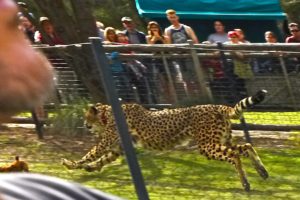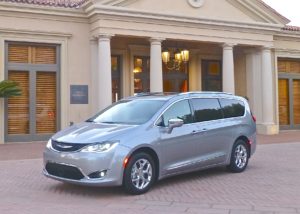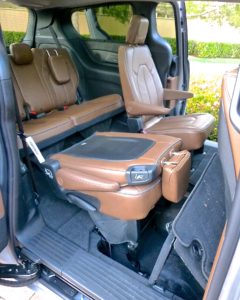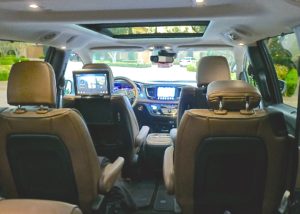Pacifica Can Handle All Family Tasks
John Gilbert
LAGUNA BEACH, Ca.—The rich memories of my childhood include our family drives, usually on Sunday afternoons, in the rural areas north of Duluth, Minnesota. From the back seat of our black, 1951 DeSoto sedan, my sister and I would join my mom and dad playing word games, usually picking some everyday object and trying to prevent the rest of the family from identifying it. While asking for clues, the common starter was: “Is it bigger than a breadbox?”
There’s no time for family drives anymore, it seems, and our own two sons are adults, growing up before current electronic connectivity, videos and smartphones replaced guessing games. And what the heck is a breadbox, anyway?
Chrysler LLC has done its best to recapture that nostalgic era of family drives and possibly rekindle the demand for the family utility of minivans when it introduced the 2017 Pacifica, a totally renovated version of its once and present — and maybe future — premier family hauler. The Pacifica is Chrysler’s new minivan, a vehicle which might best be described as the automotive version of a breadbox; it stores people the way breadboxes used to store assorted loaves of fresh-baked bread.
In a unique idea, Chrysler invited auto journalists to The Resort at Pelican Hills, just south of Los Angeles, and to bring our families along. No limit on how many kids in a family, but they they had to fit into one room. However, The Resort at Pelican Hills offers more than just a room. More of a series of individual 3-bedroom condos complete with three bathrooms, a living room, dining room, kitchen, and enormous space, including outside decks, overlooking over a golf course with the Pacific Ocean just beyond.
How sophisticated was The Resort at Pelican Hills? The condo immediately next to us housed Ben Roethlisberger, the gigantic Pittsburgh Steelers quarterback, with a revolving assortment of friends. Ben usually left the garage door open, giving us a good view of his gleaming white Ferrari, and a more symbolic view of why big-time quarterbacks need multi-million-dollar annual salaries.
For the auto journalists, there was no age limit on the “kids.” Unfortunately our younger son, Jeff, couldn’t join his older brother, Jack, and my wife, Joan, and me. Joan and Jack always have contributed opinions to my reviews for Newcarpicks, so it was sort of like a field trip for the three of us. Joan always has helps me evaluate test cars at home, and Jack provides views, and supplements my passion for photographing cars at car shows or Midwest Auto Media Association rally events.
As we first approached the Pacifica, and before we had even climbed aboard, Joan said: “I like the design. It’s really beautiful and sleek — especially for a minivan.”
The plan included each family getting a Pacifica for a full day of free time, either on your own or following planned trips itineraries in Los Angeles, Hollywood, or on down the Coast to San Diego — the perfect way to learn first-hand all the Pacifica could offer as a contemporary family hauler.
The striking appearance of the exterior led to some questions for chief designer Brandon Faurote, because while designing the Pacifica, it was an all-new breadbox, but a breadbox nonetheless. “There’s no better way to move people and cargo than a minivan,” he said. “If you have three kids, there’s nothing better.”
On the road, we drove south, and then through the Southern California mountain curves inland from San Diego to the Safari affiliate location of the world-famous San Diego Zoo. It was plenty twisty, but the tight steering allowed us trace perfect arcs around the tightest, more like a sports sedan. As if to provide a subtle analogy, the Safari staff provided a speed test with a cheetah, which sped past in an elongated cage, chasing a spring-loaded bait and nearly catching it, with a 0-70 mph burst that eluded the naked eye, but, fortunately, was caught on camera.

A cheetah flashed by on a 0-70 speed test at Safari, near San Diego, and while it beat the naked eye, it couldn’t beat the Leica camera lens.
Later we cruised to Laguna Beach, various coastal towns and shops, restaurants and other attractions, always in spacious comfort. Jack, mostly encased in the rear seats, enjoyed the flexibility of the Stow ‘n Go arrangement to fold the second-row buckets flat into the floor. He didn’t get as much time as he’d have liked to watch the video screen and use the wireless speakers on the optional Infinity sound system, but he could appreciate the tight stability and handling from back there.
“It’s the perfect vehicle,” said Jack, a confirmed 2-door coupe zealot who once played guitar in a rock band. “It handles like a sports car, with enough room for the whole band. The Wi-Fi on board is one of the most useful things ever.
“It’s extremely quiet, for as rigid as the suspension is. Maybe it’s because we’re driving on roads without potholes. We’re just not used to that in Minnesota. And the Stow ‘n’ Go seats are now power operated.”
Joan was the ideal scrutinizer for the finer interior touches, such as the large and stylishly finished nav screen, flush with its border. She liked the soft-touch material that covered the whole dash and gave it an extra feel of luxury.
“Inside, I like everything, including the layout of the instruments and things like the rotating shift dial on the console,” said Joan. She was more impressed the second day, when we moved up from the fully competent base model to the Limited. “Back seats are not always comfortable in minivans, but this one is,” she said. “The front seats are more comfortable in the Limited, too. If we had a family of young kids, I’d get one of these, because there is not one thing to not like.
“The way it’s set up for baby seats is great, and the Stow ‘n’ Go gives you a place to put your purse or other valuables. Every car should have that. They must have a mom on the design staff.”
That was all part of the plan, said Faurote, the designer who created a vehicle that most resembles an amalgamation of a minivan, SUV, and station wagon. “We wanted to appeal to both side of the brain, both the rational and emotional sides. We started from the ground up and changed the proportions by stretching the wheelbase, enlarging the wheels and tires, and widening the track significantly to give it a really strong presence on the road. We tried to round the corners off the box, to make it more appealing to the emotional side, versus the rational side. Something people really wanted to buy, rather than just needed to buy.”
In this connective age, we all know that features such as the Pacifica’s video screens in the backrests of the front buckets, and the larger rear-seat ceiling screen, have become the modern method for eliminating the constant “Are we there yet?” questions from kids who have lost their patience.
That, in fact, was perhaps Joan’s only criticism. We know that video games have become the pacifier/babysitter for a new generation. Can we imagine kids from today someday reminiscing about how they can’t remember anything about the family trip to the Grand Canyon, but that was the trip where they recorded their highest score in (insert name of favorite overused video)?
“I wouldn’t want the back video screens,” said Joan, recalling some great memories from actually looking out the windows at the real world speeding past, the way we used to do when our sons were kids.






 John Gilbert is a lifetime Minnesotan and career journalist, specializing in cars and sports during and since spending 30 years at the Minneapolis Tribune, now the Star Tribune. More recently, he has continued translating the high-tech world of autos and sharing his passionate insights as a freelance writer/photographer/broadcaster. A member of the prestigious North American Car and Truck of the Year jury since 1993. John can be heard Monday-Friday from 9-11am on 610 KDAL(www.kdal610.com) on the "John Gilbert Show," and writes a column in the Duluth Reader.
John Gilbert is a lifetime Minnesotan and career journalist, specializing in cars and sports during and since spending 30 years at the Minneapolis Tribune, now the Star Tribune. More recently, he has continued translating the high-tech world of autos and sharing his passionate insights as a freelance writer/photographer/broadcaster. A member of the prestigious North American Car and Truck of the Year jury since 1993. John can be heard Monday-Friday from 9-11am on 610 KDAL(www.kdal610.com) on the "John Gilbert Show," and writes a column in the Duluth Reader.